A lawsuit (PDF) has been filed in the death of Martin Greenough, the man who was killed while bicycling on NE Portland Highway (a.k.a. Lombard) on December 12th of last year.
Greenough’s family filed the lawsuit yesterday. The suit says that the City of Portland, the State of Oregon, and the man who hit Greenough, Kenneth Smith, are all at fault for his death and are asking for $3.6 million in damages.
As we covered at length here on BikePortland, Greenough was hit in a section of Lombard — where the bike lane stops and the road narrows under the NE 42nd Avenue overpass — that was a known danger spot. We reported on the exact location just one day before he was hit. Tragically however, we learned Greenough was new to town and was very likely following the route suggested on official city and regional bike maps.
In the lawsuit, Greenough’s lawyer claims both the Oregon Department of Transportation and the Portland Bureau of Transportion had been aware of the “pinch point” for at least a year before the collision and that they failed to “failed to provide for safe travel for both motor vehicles and bicycles.”
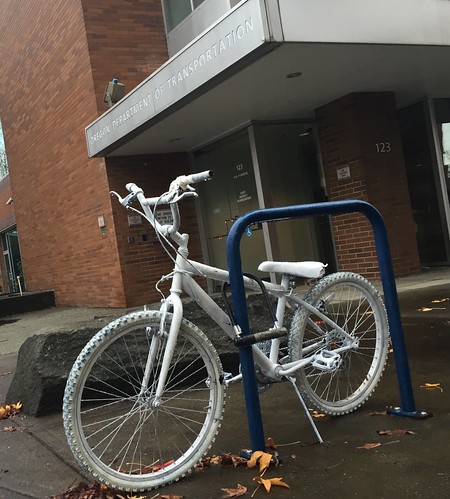
(Photo: J. Maus/BikePortland)
Advertisement
Specifically, the lawsuit seeks up to $2 million from ODOT because the agency allegedly did not follow its own administrative rule that governs the signage and marking of bicycle lanes and paths (OAR 734-020-0060). For PBOT, the lawsuit asks for a maximum of $682,000 for negligence due to the city’s failure to abide by its own rules for defining bicycling lanes with pavement markings.
Back in January we visited the site where Greenough was killed and detailed why this stretch of road is dangerous by design.
The third defendant in the case is Kenneth Smith, whom the lawsuit blames for driving while intoxicated, failing to maintain control of his vehicle, failing to stop and administer aid, and so on. The suit says Smith is guilty of first degree manslaughter.
According to The Oregonian, Smith has pleaded not guilty and is scheduled to go to trial next week to contest the charges.
The is the third lawsuit filed against ODOT in the last three months. In February they were sued by disability rights advocates for not keeping up with safety infrastructure required by ADA law and earlier this month a class-action suit was filed against the agency for a spate of crashes allegedly caused by faulty design of a flyover ramp on Highway 217.
— Jonathan Maus, (503) 706-8804 – jonathan@bikeportland.org
Our work is supported by subscribers. Please become one today.



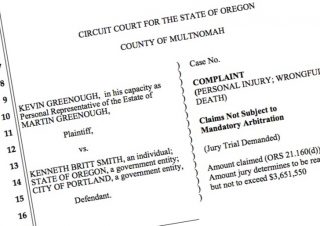
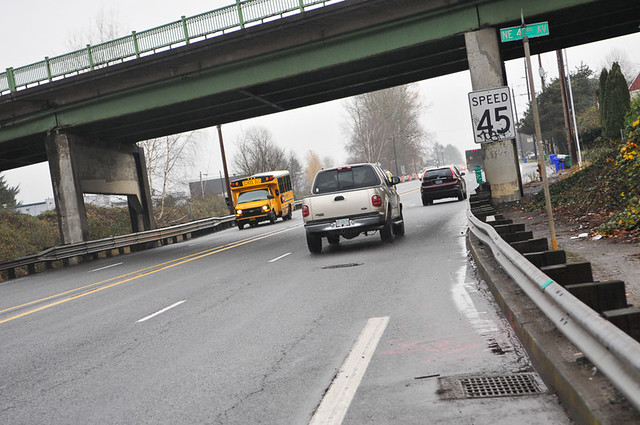
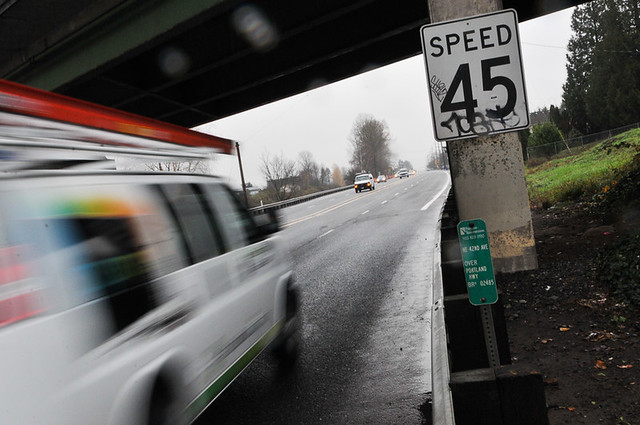
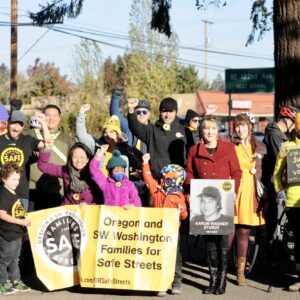
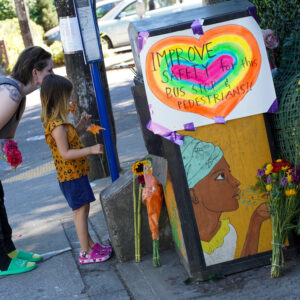
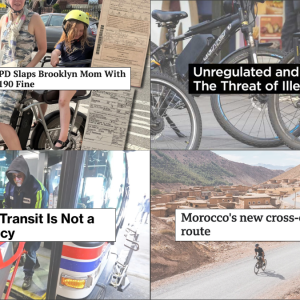
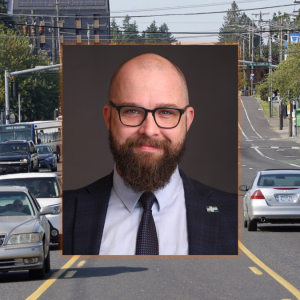
Thanks for reading.
BikePortland has served this community with independent community journalism since 2005. We rely on subscriptions from readers like you to survive. Your financial support is vital in keeping this valuable resource alive and well.
Please subscribe today to strengthen and expand our work.
Maybe this is how the automobile age will end. As the danger, destruction and pollution of the automobile and its infrastructure become more and more apparent ,its victims (of all kinds) will press their rightful grievences and slowly chew away at the financial infrastructure of those who support and profit from it. Hopefully this will eventualy bring home the message that a few have known all along. Once you have to add it up and pay all the true costs, and not shift them off to others, the automobile never really made sense.
Uhm… automobiles never made sense? Not even on those countless times you’ve ridden in one or purchased a product that was transported in many of them between the factory and your hands?
Sounds like your gluten free veggie dogs and organic free range lager were delivered by pack mule?!
Sounds like your smart phone and laptop and bicycle were all plucked from trees in the yard?!
Oh dang, or drones?! It was drones, wasn’t it!!
Please do write a guest article about your life that doesn’t intersect with the use of “automobiles” so others can follow suit.
It feels good to get the “likes” but in reality we all vote ‘pro-automobile’ any time we buy anything that wasn’t made on site.
PEASANT: Feudalism is bad
ME: But how can you say feudalism is bad when you’re wearing rags MADE UNDER FEUDALISM
PEASANT: [dies of plague]
https://twitter.com/mammothfactory/status/719009193894768640
Hear ye, Hear ye, are these iPhone cases and Swiffer refills not the peasant rags of our times?!
Let us rise up and smash the Lordes of Amazon Prime Manor so that they never force our own demise again! It is time they invest in a fleet of stagecoaches to bring my wares unto me!
Dark lords are they.
Ah, the inevitable ad hominem argument that comes up when one discusses topics such as poverty , climate change or automobiles. A perfect example is the argument that climate change deniers make that humans can’t be affecting the climate because Al Gore flys around in a plane so he is a hippocrite and must be wrong. Or that Pope Francis can’t be an advocate for the poor because he lives in a palace. If we are too make any progress in the world we must separate a persons ability to make a logical argument from their ability to be a pure and perfect example. Though making oneself a pure gandhian example is admirable, and may help ones argument, it in itself should not effect the validity of ones argument.
The great social thinker Ivan Illich termed the automobile a radical monopoly. Its presence has crowded out or eliminated other options. If we had charted a saner course in the years since 1920 or so we may not have dismantled our streetcar system, or defunded passenger rail, our invented the automobile-only suburb. I don’t think our grandchildren will look back at the 100 year period from 1920 to 2020 and think that burning up millions of years of stored sunlight in a brief orgy of automobile madness, only to leave an earth scared with asphalt and a damaged climate and was worth the costs.
Bikes heavily leverage automobile infrastructure. Without that source of income (fuel taxes) how will sufficient cycling infrastructure be built?
“Without that source of income (fuel taxes) how will sufficient cycling infrastructure be built?”
Let me ask you this –
Without that source of threat (speed, mass, probability of distracted pilot) would we need cycling infrastructure at all?
I can only assume you mean this sarcastically, since bikes traveled the earth before asphalt roads, and fuel taxes (the pittance that they are) don’t come close to making up for the costs imposed by automobiles.
he is very fond of saying such things here. Not quite sure what it is about, this need to assert equivalence where there is none.
Looks like the suit says first-degree manslaughter, not homicide, unless I’m reading it wrong.
genus versus species .. http://www.oregonlaws.org/ors/163.005
Manslaughter is a category of homicide.
Regardless of the merits of this case, or what you think of litigating morality via lawsuits, I think we can all agree that in the world we’re currently residing in, there comes a point where money (and taking it forcibly) really is the only way you can get through to people in power. Nothing else will work, no amount of arguing, persuading, etc. Money is what matters, and money is what flips the switch on and off in a mind.
It’s sad, but it’s reality.
It will certainly get someones attention. I am doubtful that this will change anything here in Oregon given our lax response to things of this nature. You need to set the forests on fire here to enact change.
Except that there are insurance policies designed to absorb just this sort of thing.
And the more law suits ODOT loses or settles the more expensive that insurance will be.
I guess a lawsuit is good….but this is ODOT. They’ll probably respond with a undisclosable settlement and commit to doing a study of the area. A study which will take four years.
That’s how the ODOT system works. Feasibility study first, environmental studies next, design studies after that… THEN they might do something. If you’re talking about re-engineering the abutments or wingwalls of the overpass it will take longer.
look again at the pictures. No wing walls, no abutments near the roadway. Replacing the guard rail with crash attenuators and moving the bike lane to behind the columns would have been a low cost fix.
I thought the City would be sued for their map, not the pavement markings they don’t control.
Yes. It would have been easy to provide a short detour for cyclists. Make an opening in the guardrail, a ramp on the curb, and a narrow strip of asphalt on the outside of the overpass supports.
Right now, a cyclist following this bike lane finds himself trapped at the overpass, either has to climb over the guardrail carrying the bike, or proceed through the narrowed section of roadway, partly concealed in the shadow the overpass, hoping that a car or truck doesn’t come along at high speed.
Good. ODOT deserves to be sued and made responsible for their deadly design. Hopefully this will result in better infra being built. This is the third ongoing lawsuit for ODOT; something has to be getting through to them – and Governor Brown for that matter.
The sad irony is that if he wins, we’re the ones who will pay.
I thought cyclists didn’t pay taxes? 😉
In all honesty though, I am willing to pay to punish ODOT if it results in a wake-up call for them to start building safer roads and best-practice cycling infrastructure. At the very least, it will get the attention of the Governor.
How is “you paying” going to punish ODOT?
It’s a sunk cost. I’ve already paid my taxes. But a penalty for ODOT means reduced funding. If ODOT knew bad design was going to cut into their funding stream, then they might make better choices in the first place. Though given how ODOT uses their funding, I’d say the less money they get to spend, the better.
On would hope. Most likely, they’ll still be the bureaucratic mess that they’ve always been. But, it’s still satisfying. I hope the guy who hit him gets what he deserves, I’m SO tired of car drivers killing or injuring cyclists and not suffering any consequences.
Nope, the insurance will pay for it.
Actually, if you are right, maybe the insurance companies will start leaning on ODOT to reduce the lawsuit threat. This is happening with the police… the insurance companies are sick of paying out when someone gets shot, and have concluded it would be cheaper to work with training the police to reduce the number of incidents.
You haven’t paid your taxes for next year.
Uh, yeah. Let’s tear down everything that a group of activists thinks is dangerous and rebuild it…because that’s inexpensive.
No system will be perfect and there will always be some fatalities in any system where a moving vehicle is present.
Heck, I can bike off of a road in the Gorge quite easily and kill myself that way. Is that bad road design?
Why do you use activist like it’s a bad word?
It’s actually good design from an auto-centric viewpoint. It’s bad design from your viewpoint.
“It’s actually good design from an auto-centric viewpoint.”
Do we want this?
Can we afford this?
Are you Robert Moses?
This is every kindergartner’s concept of “fair”—if it benefits me, it’s fair. If it doesn’t, it’s no fair!
I think “good” needs to be thought of in a larger context, such as what is “good” for our long-term prospects as citizens of viable (sustainable) cities and a shrinking planet.
Designing roads solely for cars surely isn’t “good for our long-term prospects as citizens of viable (sustainable) cities and a shrinking planet”
And won’t that mean less money to build safer roads? Will losing lawsuits such as this actually have the desired effect of making them safer for us vulnerable road users? I don’t know enough about ODOT’s budget and constraints to know if this will “encourage” them to shift some dollars in the budget to safety enhancements. Hopefully someone who does can chime in.
It might change who is in charge of ODOT.
Good point.
“And won’t that mean less money to build safer roads?”
Since when is/was that an ODOT priority? 😉
Absolutely ridiculous that this stretch is 4 lanes and 45mph. Totally unnecessary and dangerous for all road users.
Like every arterial where I live.
there are few 45 mph zones in Portland, so you must not live in Portland?
I believe he lives in Beaverton, where nearly every road is 4-lane 45 MPH (and Washington County is widening a lot of those roads too!). I can personally attest that it is absolutely hellish walking or biking near these roads.
Yup.
People call me crazy when they find out I use part of the zoobomb route on the shoulder of 26 from the Zoo to Jefferson in the morning to get to work.
Them: “Isn’t that dangerous”
Me: “It’s safer than Murray Blvd…”
That route is safer than using Vista/ Humphrey. I used to ride that way a lot because it was safe and fast.
Also true. I stopped using Hewitt/Patton/Broadway Dr. into town because of all the curves and required braking. 26 is a straight shot, no curves, no braking; it saves my rims and 7 minutes.
“…Beaverton, where nearly every road is 4-lane 45 MPH (and Washington County is widening a lot of those roads too!). …” adam
Most roads in and around Beaverton, are not 4 lane 45 mph roads. Though the thoroughfares, such as Farmington, Beav-Hillsdale, Canyon Rd, Walker, 185th, parts of Cornell, are 4 lane roads, my experience has been over many years riding in the area, that there’s usually alternative routes for many rides.
Plenty of the thoroughfares have bike lanes too. Their having them doesn’t necessarily make them great riding environments…personally, I’d much prefer riding nearby neighborhoods streets or less traveled two lane roads, even though they don’t have bike lanes. I’d say it’s true though, that Beaverton and Washington County could do a far better job than they are, of road design planning for travel by means other than motor vehicle. There should be serious planning and budgeting going on, for the provision of protected bike infrastructure on what are, or are likely to be in future…certain particularly key routes for biking between points in the city and county.
While out in North Portland on east Lombard, Greenough’s options to a high speed thoroughfare for his route on a bike, weren’t great, that provision for biking throughout the metro area is often lacking, isn’t uncommon. This comes from a time and public point of view in our area…which still largely prevails…that biking really is not a major, common means of travel for the public, which the public should go to extraordinary lengths to provide for.
With a mere 20 percent, and in all likelihood, a far smaller percent of people traveling the road by bike within Portland city limits and beyond, it to me seems very doubtful that the public would be prepared to budget ODOT with a sufficient amount of money to rework all the roads in the heavily populated counties, let alone the state…to provide people biking with infrastructure that could reasonably isolate them from the danger to them posed by people’s use of roads with motor vehicles. Not gonna happen, period.
When somebody feels they need to sue ODOT or any government dept…they’re suing ‘us’, as in ‘the public’. Suing ODOT because it failed to put up some signs it was supposed to, is fine. The department was lax in that respect, but it’s probably going to be very hard to prove that it not doing so, made the road “…deadly…”, your word.
AH said: “….in Beaverton, where nearly every road is 4-lane 45 MPH…”
I don’t mind riding on TV Highway – it has, in most places, a good wide shoulder to ride on although it isn’t necessarily meant to be a “bike lane”. For going a long way with few stops, it works. Hall is another good bike road in most places – it has a bike lane or wide shoulder in most places – but not all. I do avoid walking on such roads and just scoot over a block or else walk thru parking lots instead of right next to the road. Much easier riding than most of Portland with all the traffic, pedestrians, intersections, overly zealous anti-bike cops, etc.
Ridiculous for the way it is currently configured. If the center area were widened to 6 feet with a concrete barrier down the middle and the bike lane also separated by a vertical concrete barrier – i.e. one car lane in each direction, 45 mph would be relatively safe.
Especially since we all know that very few drivers adhere to the speed limit.
Reducing to one auto lane in each direction would mean no more passing, so one driver going the speed limit would keep those behind her going the speed limit.
Unfortunately, most people think that’s a bad thing.
Mostly, those who drive recklessly will now just pass in the oncoming traffic lane. Unless it becomes like a rural highway where you can legally pass using the oncoming lane.
BTW,
this common knowledge of speeding thing, were you talking this road, or all roads, and how do you know?
Ha ha, really?
It’s not dangerous for drivers…I’ve never felt ‘in danger’ there.
It would be nice if the financial liability were such that where there is no truly safe place on particular roads for all users, that road would simply be closed to motor vehicle traffic which is causing the potential for harm.
honestly it could go completely the other way, no? close to VRUs any roadway where the posted speed limit is >25mph without separate and protected lanes (not just paint).
That’s what freeways are for. Beyond that, it just won’t work. Prioritizing fast auto traffic everywhere isn’t sustainable even if all cars are powered by infinite unicorns and operated by infallible software.
technically the area of this specific accident is classified as a highway, right? Not arguing FOR faster auto traffic, but I think outcome of an issue like this is less likely improved infrastructure and more likely to try to ban VRUs on specific roadways….kind of like the other poster who laments the coming “bike at your own risk” signage. I don’t think we are within 20yrs of an auto-less society, so I’m not going to pine away for the demise of cars, but I will sign up for slower speeds as population densities grow
You’re a dreamer, but certainly not the only one. Thanks for expressing such a delightful idea.
We almost never hold motorists accountable, and now instead of doing so, we’re going to shift the blame to the government.
If I suddenly found myself in the business of ensuring that a bunch of negligent motorists didn’t kill each other I would exit that business immediately.
The answer has always been to hold people criminally and financially liable for their negligence. We, as a society, refuse to do so.
I agree with you, but who do you think needs to hold the motorists accountable? The government.
Though you have to admit… in this location at least, the road design almost guaranteed that someone was going to get squished.
There are plenty of people around here (myself included) who not be terribly unhappy to see ODOT exit the road business.
!!!! reply to JeffS !!!!
But the suits allege that the organizations didn’t follow their own policies that were designed to (try to) keep all road users safe. Not that the motorist isn’t also accountable, but there were shortcomings here that may have attributed to his death.
This, by the way, is exactly the reason I say signs are useless, except for liability. The parties will settle, the insurance policies will cover the settlements, and the engineers will put up a sign so the next time it happens they can point to evidence that they weren’t negligent in documenting the hazard.
Quote: “We almost never hold motorists accountable…..”
If I am not mistaken, the driver was a non-caucasian. It would be racisss to hold them accountable so don’t even think about it or you’ll be destroyed by the public firestorm.
You are mistaken.
I am?
http://koin.com/2015/12/12/bicyclist-hit-dies-on-ne-portland-highway/
Mixed feelings about this. Next story will be “ODOT uses money designated for improved safety to remove all bike lanes and install signs on all ODOT owned roads ‘Cycle at your own risk.”
“Next story”?
Isn’t this exactly what is (already) happening on SE 26th (or what ODOT has tried to strong-arm PBOT into doing there)?
I hope the 217 flyover lawsuit is dismissed. Exceeding the advisory speed by 30mph while eating a donut and you scratched your paint? Boo hoo. Those drivers should be held accountable for their own recklessness.
What can the city do about a state highway? Strictly enforce the speed limit and minimum passing distance in these spaces — do it early and often until drivers complain very loudly about the bike lane gap. Right now, drivers don’t even notice it until they are very near the point of hitting someone on a bike.
What? We can’t afford to do enforcement because courts dismiss these cases? Maybe time to sue the court, but still the Portland Police Bureau needs to do the job.
ODOT will only respond to lawsuits of a reasonable amount. 2mill way little for them to care about VRUs. Try 200mil, and make class action. I hope the recent lawsuits are only the start, and previous ODOT victims will be encouraged to file also. It’s the only way to get change.
This is the only way for ODOT to change, sadly. It shouldn’t require death and dismemberment to make our cities safer.
they will lose. he’d still be alive if the driver had been sober.
Sure, because the sober drivers aren’t running into anything, right?
not nearly as often.
Motor vehicles operated by sober drivers have no less destructive force than those operated by impaired drivers.
Unless people drive faster when they’ve been drinking.
Or unless sober drivers don’t hit anyone.
But the accident rates are surely different, no?
you’re delusional.
You might look at the first picture of the guard rail. It is not the first time that the rail has been hit by a motor vehicle. The sudden bend of the rail should have been a warning to the powers that be that there was a problem in the overpass configuration. The 45 MPH sign was a target. Guaranteed that a cyclist would be hit.
Bent guardrail? That’s how you know it’s working!
Aren’t people overlooking the fact that the guy was high?
It doesn’t look like that to me. He is also named in the suit. But the point seems to be that Martin was killed right there, not 100 feet earlier or later. The family seems quite able to imagine that *both* the road design and the driver’s incapacitation were factors.
Murphy’s law: You will always be at a pinch point in the road when a dope head passes your bicycle.
If he hadn’t been high would you agree the road design is flawed?
A sober person can make better decisions than one under the influence. So even if the design is flawed, it will be better navigated by someone with fully functioning faculties.
but that detracts from the whole “the road is at fault” narrative pushed by folks on this blog.
The roadway design isn’t perfect – possibly the road and bridge existed before bike lanes – thus those weren’t considered during original construction and that was probably the standard at that time. Had the driver not been drinking this accident probably would not have occurred. AND who knows what the cyclist did to contribute to the accident – possibly such things as swerved into the traffic to avoid something on the side of the road like a dog or cat, or perhaps did not make himself visible enough using lights, reflective material, etc.
But if they win their lawsuit, the state will not have to pay a cent; the rest of us will pay when they pass on the costs to the taxpayers.
My understanding is that the driver was stoned, not drunk.
We already pay the costs as taxpayers. These organizations carry bonds whose premiums we pay, and yes those premiums will rise if this happens too much, but hopefully some diligence in improving the road design happens so this will be prevented in the future. (I think that’s the point, in line with the proposal his sister wrote to the organizations that they consider formally developing the worn trail inside of the guardrail that pedestrians already use).
As an example of the costs we already pay due to the power of these insurance companies, my county shelled out ~$300K to replace curbs on our local expressway with new curbs. No incidents related to problems with the old curbs were ever reported, no sidewalks or improvements were piggy-backed onto the project, and in fact the shoulder – which is highly used by bicycle commuters – was narrowed as a result. The county planner who explained this to me was actually pretty upset at the “useless chunk” it took out of his budget because it prolonged a number of ADA compliance updates he’s also responsible for. (The new curbs also cause debris accumulations that demand more frequent street sweeping and drain cleanup during the rainy season).
I doubt hi-viz would have helped in this situation, and we don’t know how much lighting Martin had, although I think the effectiveness of those are negated by the fact that the road forces bicyclists into the middle of it on very short notice.
The guy driving was heavily impaired, bonked out of his mind on pot.
As undesirably less safe as the infrastructure for biking on this point of Lombard was, apparently, collisions involving motor vehicles and bikes on this point of the road, are very rare. In fact, has there been any other reported bike-car collision occurring on this point of the road?
It stands to reason that on this point along Lombard, daily, tens of thousands of people driving, and many more, manage to drive along this section of Lombard, and other similarly risky for people riding, roads throughout the Metro area and the state…without mishap. Where there is a mishap, it seems to be the reason, is that one or more of the parties involved, was somehow impaired, drunk, stoned, distracted, whatever. Not impaired, people using the road, regularly handle difficult road infrastructure situations quite well.
Efforts to get safer infrastructure for biking, are worthy. Involving the public more extensively in discussions about the increasing importance of biking as a means of practical travel is good. Conclusions drawn that the type of collision Greenough was involved in, was due to poor infrastructure, rather than almost exclusively to someone disastrously incompetent to drive, is not good.
Almost any standard paint designated bike lane, or shoulder on the road, anywhere, leaves people biking to virtually the same danger from impaired drivers that Martin Greenough unfortunately was subject to.
“Almost any standard paint designated bike lane, or shoulder on the road, anywhere, leaves people biking to virtually the same danger from impaired drivers that Martin Greenough unfortunately was subject to.”
The difference is between an impaired or distracted driver leaving their lane of travel, as in Melanie Souza driving over Stan Wicka in the bike lane while she was busy texting, or a motorist driving straight within their lane of travel and not having enough time to react to something unexpected, like coming upon a bicyclist in the dark who they expect to be to the right side of the road (or not there at all).
Make no mistake, in no way am I arguing that the driver’s impairment (and quite possibly speed of travel) didn’t contribute to the lack of a safe reaction time, but again I submit it’s entirely possible for a bicyclist in the middle of a lane of travel in the dark to be run down by even an unimpaired driver, simply due to the fact that typical roadway configurations (are supposed to) provide for linear lane travel, or at least effective warnings whenever there is a deviation. (And I’ll also add that I don’t consider signs to be effective, but I’m sure you’ve seen me write that before).
When bridges are below some standard height (14′ something?), they tend to be outfit with yellow flashing lights to prevent trailer collisions. When car travel lanes drop, there are rules governing where advance warning signs get placed, typically in addition to a sequence of massive arrows on the roadway (which I believe to be more effective than signs). What we have here is a lane of travel that literally disappears – or at least becomes dangerously substandard – with insufficient warning to users of either affected travel lane.
The bottom line is that regardless of whether Martin would be alive today with a sober, attentive, speed-limit-compliant driver coming upon him, the situation on Lombard creates a hazard for users of both travel lanes, and any improvement in the flow of travel or warning of the disruption may prevent future collisions due to the forced departure of predictable trajectory by bicyclists using the route.
Note that Lombard isn’t the only situation where roadway design has neglected bicyclist safety. For an even better example visit Page Mill Road in Palo Alto going westbound under highway I-280 where Jeff Donnelly was run down last year.
Despite the bike lane configuration forcing westbound bicyclists to cross two lanes of 50 MPH freeway traffic, the initial police report stated that Jeff was supposed to be in the bike lane but for an unknown reason was in the (car) travel lane. The report was later amended to state that officers had reason to believe Jeff changed lanes unsafely.
https://bikesiliconvalley.org/2015/11/fatality-at-page-mill-interchange
https://bikesiliconvalley.org/2015/12/page-mill280-interim-improvement-process
https://bikesiliconvalley.org/2016/03/public-meeting-page-mill280-improvements-april-20
http://www.nbcbayarea.com/news/local/Family-Launches-Investigation-Into-Silicon-Valley-Executives-Death-365390781.html
The driver was sober and it was in the daylight (with the sun behind them).
Incidentally, the next intersection north of this was dangerous for bicyclists until Lauren Ward’s husband helped force change there after her death:
https://bikesiliconvalley.org/2011/02/alpine-rd-at-280-redesign
https://bikesiliconvalley.org/2013/10/alpine-road-goes-green
Quote: “Note that Lombard isn’t the only situation where roadway design has neglected bicyclist safety.”
I’d say that 99.99% of streets and roads in the USA are somewhat risky for cyclists. Paint does not stop cars (bike lanes) if the driver is inattentive (all drivers are inattentive at least part of the time).
We can whine, complain, sue drivers, sue the government, burn down city hall and ODOT, and 99.99% of streets and roads in the USA will continue to be risky for cyclists (and for drivers and peds). That will not change quickly if ever. In another decade, perhaps only 99.9% of roads will be risky for cyclists – but that’s probably overly optimistic. There is only so much money we can spend for cycling infrastructure – fact of life that no amount of tragedy, anguish, death, lawsuits, riots, etc will change.
Moral to the story? Make yourself extremely visible so if some ahole in a car hits you they will not be able to say “I did not see the cyclist” and get any sympathy from anyone.
I think the problem runs deeper than “we don’t have the money for bike/ped improvements”… that’s actually systemic. Some call it whining, others call it activism, but there are ways you can get involved with identifying shortcomings on our roadways and bringing proposals to the responsible authorities – if you read the Bike Portland article on this exact problem spot that was published just a day before Martin was killed, you may recall that cyclists had previously brought this to ODOT’s attention, and they agreed that it was a problem that needed to be addressed, albeit an expensive one that couldn’t be solved with paint.
http://bikeportland.org/2015/12/11/scary-pinch-point-on-lombard-puts-new-orcycle-trouble-reporting-app-to-the-test-170071
For most of my life, considerable amounts of our tax money have gone to making infrastructure better for cars, and for addressing roadway safety by making cars safer. The driving force behind this has unquestionably been the insurance industry and their lobbyists, from seatbelts to air bags to anti-lock brakes, and the march continues with lane incursion warning systems, computerized brake overrides, arrays of sensors and compute-intensive imaging systems designed to detect pedestrians and bicyclists, and of course government-funded Vehicle-to-Vehicle (V2V) and Vehicle-to-Infrastructure (V2I) research.
http://www.its.dot.gov/connected_vehicle/connected_vehicle_research.htm
Now, I won’t be the one to argue hi-viz or lighting with you, as it’s been argued ad nauseum on this forum, and I’m rarely if ever one that can be accused of riding invisible (I’ve actually run lighting workshops as part of my bike safety instruction). But my point is that advocacy, activism, and even lawsuits are not bleeding our poor gub’ment dry, and that there are indeed problem spots that need to be addressed as bicycling continues to grow in popularity across our country. Surely paint won’t keep every driver in their lane, but it is the fundamental guide to people’s expectations on our roadways, so a good place to start.
In situations like Lombard, though, it comes down to priority. ODOT underestimated the problem, and admits that it’s too expensive to solve because they can’t do it with just paint. Now that Greenaugh has been killed there – like the changes down here that came from the deaths of Ward and Donnelly – we’ll see if they’re willing to escalate that priority.
“Moral to the story? Make yourself extremely visible so if some ahole in a car hits you they will not be able to say “I did not see the cyclist” and get any sympathy from anyone.”
That would be great if it worked.
“…apparently, collisions involving motor vehicles and bikes on this point of the road, are very rare. In fact, has there been any other reported bike-car collision occurring on this point of the road?”
This is a line of reasoning that results in perpetuation of the status quo. “Incidents” are likely rare here because most bicyclists are too intimidated to ride here. If we could just make all roads so scary that no bicyclists would dare venture out, then problem solved! Martin’s “problem” was that he was new to the area and on the map, this looked like a direct route with a bike lane all the way. Mr. Greenough was lured onto this stretch of road without full knowledge of the danger. Among locals with such knowledge of the danger, many may decide to steer clear of a convenient route because they know it’s dangerous. The fewer cyclists that are present, the more “rare” incidents become.
What we need is a bike counter under this overpass to see how many bicyclists pass by on the roadway, then take “incidents” as a percentage of roadway traversals of this area. It is my understanding that “incidents” (at least fatal ones) are rare on the Hawthorne bridge as well, but that rate of incidents would be far, far smaller than the rate of incidents (as a percentage of bike trips) at the Lombard location.
As another comparison, how many incidents of vehicle damage were reported at the I-5/217 flyover ramp? How many vehicles do you think pass over that location daily? Yearly? Even that rate of incidents is likely far lower than that of bicycle fatalities on Lombard. Furthermore, in the freeway ramp case, we are talking about mostly vehicle damage, whereas in the Lombard case, the “incident” is an actual death. It’s just my opinion, but government should probably focus on proven deadly problems before worrying about vehicle-denting issues.
Quote: “My understanding is that the driver was stoned, not drunk.” You are correct – thanks.
Quote: “I doubt hi-viz would have helped in this situation,….” You may be correct. We will never know – maybe he was very visible – I have no idea – but if he wasn’t then perhaps it would have made a difference.
Which would you prefer to be while riding this section of roadway at night: Lit up like a Christmas Tree, or just the bare minimum one dim red light on the back?
If you want to know what some Oregon fisherman think of the bike riders…
http://www.ifish.net/board/showthread.php?t=1227338
That is some foolish nonsense they are talking there. Yikes. I guess it is good to know how angry and ignorant some people are but it sure is dispiriting.
Why would I care what some people who like fishing think about people riding bikes?
Perhaps because they ‘share’ the roads with us? Are trying (by their own admission) to ‘teach us some lessons’ about what they think we should/should not be doing on their roads?
Have you learned anything by reading those comments? Or just got yourself upset?
I didn’t find myself upset. I guess intrigued might be closer. I learned a lot about the degree to which one’s perspective, who one associates with, shapes how you see others, see the world. I’m fascinated by ignorance, by the inability to recognize that people who happen to be on bikes might be just as legitimate road users as these fisherman in their big rigs. I blame some of this on our longstanding association of bicycling in this country with sport and recreation.
People say awful and stupid things on the Internet, and it doesn’t mean much. I read about one person who seemed obsessed with horse stabbings and texting bees. I disregarded those comments as the ravings of a total lunatic.
Bees can text?!
I know! It’s crazy! (And a bit terrifying to see!)
So that’s why they keep flying into my helmet vents!
From the original post on the fishing website:
“Since our society insists on settling every difference in a litigious manner, both for compensation and for punitive measures, and insists on using money as a means of initiating every conceivable social change, why not sue the city for making bike lanes everywhere, and then making them illogical and unsafe?”
Basically the fisherman is saying what many are saying in posts above: sue, sue, sue, the pants off the government for making bad bike infrastructure until they are forced to make it better…………..etc, etc, etc.
With one crucial difference. I didn’t get anything constructive out of the post but got the impression that their reason for advocating these suits was an attempt to make the whole bike menace disappear.
“I blame some of this on our longstanding association of bicycling in this country with sport and recreation.”
…And childhood/childishness
I post links like this every now and then for people like you 9watts. The links aren’t for everyone, and I don’t expect anyone to read them. The reason I post this link here is because there is a pinch point on 99E heading north into Milwaukie on a downhill. I’ve had problems there in before and stuff like this needs to be discussed and understood by everyone that uses the roads.
“there is a pinch point on 99E heading north into Milwaukie on a downhill. ”
I know it well. Heading South under the train trestle is the narrowest piece of ‘bike lane’ I think I’ve ever met. Maybe going North too; I haven’t noticed it going the other direction.
It’s not the fastest place to ride, but isn’t the trolley trail/sidewalk along 99e there a real improvement? Or am I thinking of a different spot?
I’m not sure about that. How does this trail navigate the trestle (the original one, not the new MAX flyover)?
Is this the same spot you were talking about?
http://imgur.com/a/N91kf
Also notice the slip lane at 22nd got a bit of an improvement last year or so.
http://bikeportland.org/2015/03/20/far-budget-trimets-orange-line-may-return-tens-millions-federal-government-135757
Yes. The middle photo where the white SUV is passing under the overpass is where I’ve experienced the pinch points, where the bike lane shrivels to, basically, nothing.
we can all find examples to support the idea we are victims.
Even an average person can see that the state created a hazardous and deadly situation. While the state will blame the driver (which they cater to increasingly), hopefully a jury will assign some negligence to ODOT. That area could be safe for pennies on the dollars. But…now a good man is dead.
Aren’t you a swell person. Wow.
If you can point to ANYTHING in my post that might suggest that I am not a “swell person” then please do so. The truth can be painful. You can avoid the truth, but you can’t avoid the consequences of avoiding the truth.